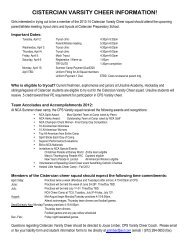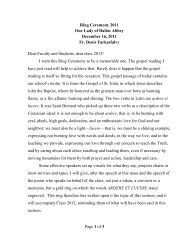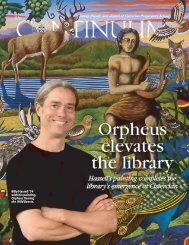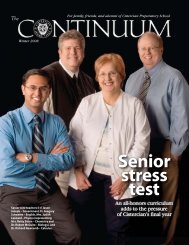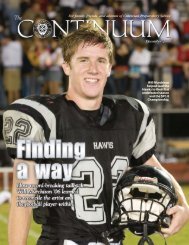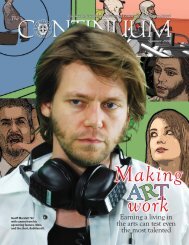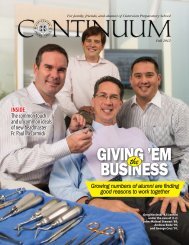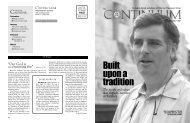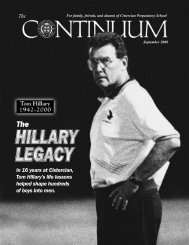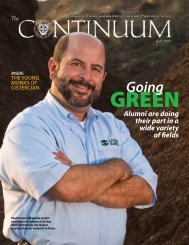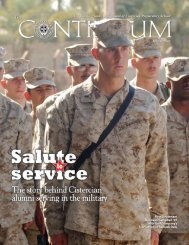Winter 09 Continuum FINAL.indd - Cistercian Preparatory School
Winter 09 Continuum FINAL.indd - Cistercian Preparatory School
Winter 09 Continuum FINAL.indd - Cistercian Preparatory School
- No tags were found...
Create successful ePaper yourself
Turn your PDF publications into a flip-book with our unique Google optimized e-Paper software.
Each progressed as their personalities and abilities dictated.Fr. Anselm, a theologian and “numbers man,” quickly took toAmerican thinking on business and fund raising. He excelled in financebut lacked social and language skills.Fr. Louis, a talented teacher and student of history, possessed asteely determination to become proficient in the English language —he refused to speak Hungarian for the most part — a challenge he hadunderestimated.The enthusiastic Fr. Damian, whoseartistic talents had yet to emerge, possessedsocial skills that helped him acclimatequickly (with some help fromhis sister who lived in America).Other <strong>Cistercian</strong>s — who had arrivedmore recently and spent muchof their time with other Hungarians atSpring Bank — had hardly even begunthe process of assimilation.This diverse group ranged in agesfrom their twenties to their forties.Many had been taught by “gentlemanpriests” in the thirties. “Gentlemanpriests” had directed many of their formationsas brothers. Others, since theapostolic visitation of 1938, had undergone a formation shaped bythe spirit of the reform movement.Despite their varied backgrounds and perspectives, the Hungarian<strong>Cistercian</strong>s had pursued a life as dictated by the reform movement— a triple vocation as priests, monks, and teachers — since theearly forties. They remained dedicated to this ideal in Texas.“My intention is that you transplant the vocation of the Hungarian<strong>Cistercian</strong>s ... so that it may take root in American soil,” AbbotWendelin had written to his American members in 1948. “Not for aminute should you forget the finis specialis (special purpose) of ourcongregation, which consists of an educational apostolate.”With a piece of land for the monastery that was close to the universityand large enough to accommodate a future prep school, the<strong>Cistercian</strong>s could practice their lifestyle in a way that was never possiblein Hungary (where the Abbey of Zirc was located far from itsurban schools).Although lively debates on many subjects would ensue, thenewly immigrated <strong>Cistercian</strong> monks now enjoyed the freedom topursue their mission. They were determined to make the most of it.ON OCTOBER 8, 1950, A 14-YEAR-OLD oblate namedMiklós Farkasfalvy beheld an eerie glimpse of the <strong>Cistercian</strong>sat their magnificent abbey in the mountainousvillage of Zirc. He had come with his fellow oblatesfrom the Benedictine school in Pannonhalma to receive his habit.The imposing baroque structure, once the home of a hundred ormore monks plus staff and novices, echoed with emptiness. OnlyAbbot Wendelin along with his secretly appointed vicar Fr. Lawrence,some coworkers, and 27 novices remained.All were packing. The Soviet regime had dictated that the <strong>Cistercian</strong>svacate the premises by the following week, October 15. Still,the community of nearly 40 gathered four times a day for the divineoffice (i.e., community prayers) and twice for common meals.“The abbot received us briefly,” Abbot Denis later recalled in a“When you are young,you enjoy going againstthe stated order of things.We enjoyed adventure,especially for thesake of Christ.”memoir, “and the next day in a very small private ceremony, Fr.Lawrence put on us the grey habits of the oblates which we wore forless than 24 hours.”According to custom, the youngest — Miklós — received hishabit last. It would be 40 years before another would receive a habitin Zirc.Despite the gloomy circumstances, Abbot Denis later wrote that“there was still an incomprehensibly happy atmosphere, translucentwith a spiritual awareness of God’s— Fr. Roch Kereszty,on life as an underground seminarianpresence, a spirit of exuberance andyouth.”“Fr. Lawrence appeared to me asthe Gate Keeper of God’s Garden,”he recalled in his memoir, “Fr. Balint(who supervised this group of oblates)as my guardian angel, Abbot Wendelinas the Great Master of the Mysteries.And the rest of us loving brothers wereinvolved in the most beautiful enterprise:monastic life in the service of anoppressed and persecuted church.”ON A SUNDAY IN AUGUST 1953,Gyula Lelóczky introduced himself toa gentleman dressed in a white suit near a statue of Beethoven in aBudapest park. The meeting had been orchestrated after Lelóczkyhad declared his intentions to become a <strong>Cistercian</strong>.For three hours on a park bench, the gentleman in the white suit,Fr. Lawrence Sigmond, learned about the young man’s calling anddescribed the difficult life of an underground seminarian.Undeterred, Lelóczky began his postulancy the following week,attending novice classes every Sunday in a detached home in Buda,where a family with one son in the <strong>Cistercian</strong> Order had rented a spareroom to two young men (who became Lelóczky’s novice mates).“It was like a regular school,” recalled Fr. Julius recently. “Onepriest taught us the Psalms and the Bible, one taught the history ofthe <strong>Cistercian</strong> Order, and another provided spiritual instruction.”On weekdays, Lelóczky lived the life of a university student.This served as his cover. On Sundays, he would tell his aunt anduncle, with whom he lived in Budapest, that he was studying at theuniversity library.“I dreamed of a Benedictine way of life so that I could stay in thesame place (as opposed to a diocesan priest),” Fr. Julius reflected.“But the monastery and community life were only a dream for us.”While Fr. Lawrence may not have known what he was trainingthese young men for, he maintained a strict novitiate: no movies ornovels. On the streets, they were not even to look at shop windowsor advertisements. Each was expected to meditate, read spiritualtexts, and keep a journal.On Feb. 22, 1954, within the confines of their small “classroom,”seven young men received their religious names, a white scapular,and the all-white habit of the <strong>Cistercian</strong>s during a Mass celebratedby Fr. Placid Csizmazia (Fr. Lawrence was absent).“We only were allowed to wear our habit in that room on thatday,” remembered Fr. Julius.Another important precaution was taken — each religious namewas revealed only to the recipient. No one but the <strong>Cistercian</strong> fathersleading the novitiate would know their religious names, safeguardingidentities in case their signed pledges were discovered.<strong>Winter</strong> 20<strong>09</strong>13



